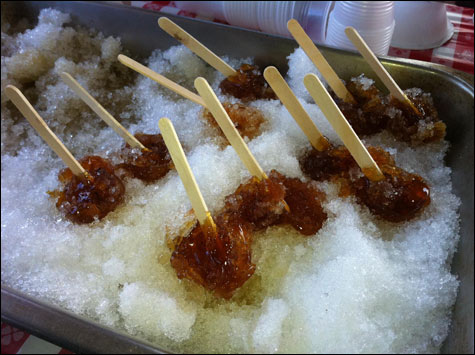
SUGAR ON SNOW Maple taffy at Harvest Hill Farms. |
A cold wind made it feel more like winter than spring this weekend, but the steam pouring out of the sugarhouse means that spring is definitely here. Bright sunshine and upbeat music from the four-piece bluegrass band, the Grassholes — who somehow played for hours with bare hands — helped keep spirits up for the hundreds of people who stood in line to sample this year's syrup at Harvest Hill Farms in Poland.
As I stood in line clutching my red raffle ticket eager for the pancake and bacon breakfast ($7 adults, $5 kids) during Maine Maple Sunday, I enjoyed a gooey blob of maple taffy ($1) twirled around a popsicle stick. Also referred to as "sugar on snow," maple taffy is made by boiling syrup to 234 degrees and then pouring it over packed snow, which causes it to thicken to a taffy consistency. Also available for purchase were goodies like maple butter and maple cream, as well as maple bread and maple whoopie pies.
When I finally made it into the intense warmth of the sugarhouse, Peter Bolduc, the owner of Harvest Hill Farms, described the process of boiling syrup. Next to him, a young man loaded the raging fire with wood and tested the consistency of the syrup. When it reached the desired temperature, the syrup was poured into containers and put out on picnic tables for guests to drown their pancakes, fried bacon, and homemade doughnuts.
I spoke with Bolduc the next day and he estimated 3500 people had come through the sugarhouse and 700 pancake breakfasts had been dished out. While Sunday was a day for the public to enjoy the syrup-making process, the sugaring season has been under way for two weeks now. The sap only runs for an average of 15 days, but Bolduc and his crew have been preparing for sugaring season since early January.
The Poland sugarhouse is his smaller, "country-feeling" operation, but in partnership with his uncle, Bolduc has a large-scale operation with 10,000 taps in Byron, in Oxford County. That commercial operation is much more efficient and uses an advanced vacuum system to get sap out of the trees as well as reverse osmosis, which removes a significant amount of water from the sap before it's boiled, saving time and resources (and they use oil instead of wood). Combined, the two sugarhouses process 100,000 gallons of sap a year, he says.
But let's not forget it takes about 40 gallons of sap to make one gallon of syrup. Making syrup involves a lot of work — tapping trees, running and periodically checking sap lines, collecting sap, boiling, and then bottling the syrup. "It's a labor of love," he says — and one of the greatest rewards is when light-amber syrup pours off the tap. "Light amber, as a sugar maker, is the pinnacle of getting everything right. It means the trees gave good quality sap, you have a clean-run operation, and it also tells you that your boiling-off process is sufficient. To get light amber you need all three of those things to happen simultaneously and it's a unit of measurement that you know what you're doing."